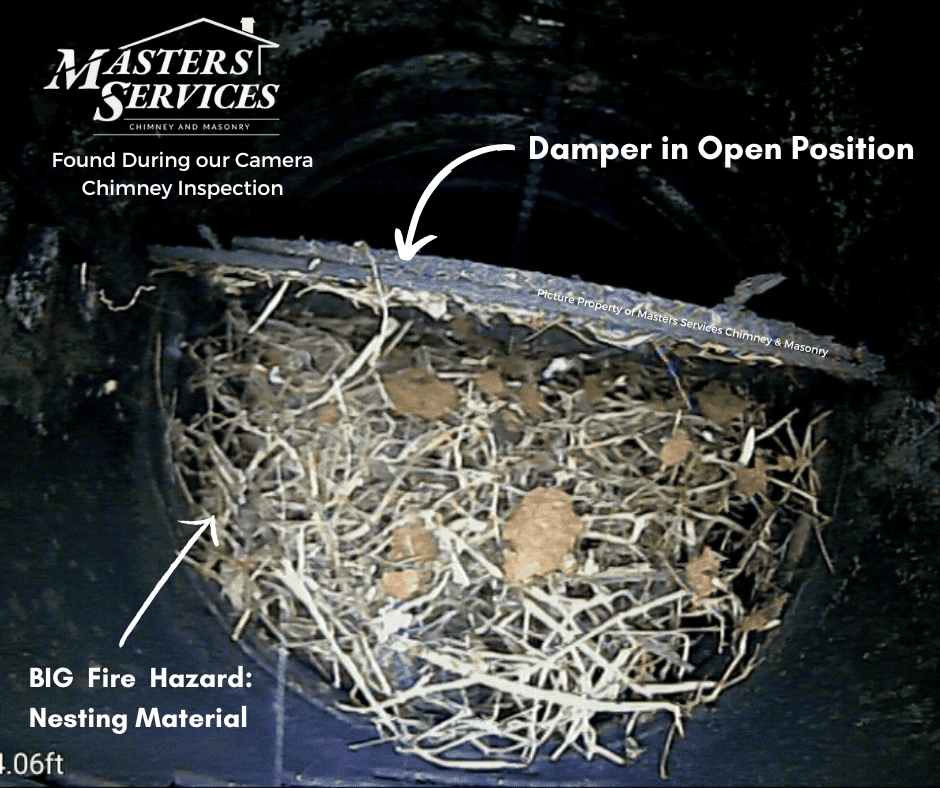Few things are as cozy and comforting as a crackling fire in the fireplace during the colder months. However, before you toss that log onto the flames and settle in with a warm blanket, there’s a crucial step you should never skip to help combat chimney fires – ensuring your chimney is clear and free of obstructions and getting a chimney inspection. In this article, we’ll explore the potential dangers of lighting a fire in a chimney that’s housing nesting animals, debris, or missing a chimney cap.
Smoke Backflow
One of the most immediate dangers of neglecting your chimney’s condition is the possibility of smoke backflow. Nesting animals, debris, or even a missing chimney cap can obstruct the flue, preventing the smoke and gases from escaping your home. When you light a fire in these conditions, the smoke has nowhere to go but back into your living space. This situation can lead to respiratory issues, and other health hazards. The presence of smoke can cause staining and damage to walls, ceilings, and furnishings. Cleaning up after a smoking incident can be challenging and expensive.
Fire Hazards
Imagine this scenario: You light a fire in your fireplace, unaware that there’s dry, flammable nesting material or debris in your chimney. The result? A potential chimney fire that can quickly spiral out of control. Not only can chimney fires be destructive, but they can also spread to the rest of your home, causing extensive damage and putting lives at risk.
Damage to the Flue:
Attempting to burn a fire with obstructions in the chimney can inflict serious harm on the flue liner or the chimney structure itself. Over time, this damage can lead to costly repairs and create additional concerns. Regular chimney maintenance and inspections are essential for identifying and addressing these issues before they become major problems.
Animal Harm:
Chimney fires, not only can pose risks to your home and family, neglecting your chimney’s condition can also harm innocent animals. If there are nesting animals in the flue, lighting a fire can result in their injury or death. This raises ethical concerns and may even lead to legal issues depending on local wildlife protection laws.
Prevention and Precautions of Chimney Fires:
To mitigate these dangers and ensure your fireplace remains a cozy haven, follow these steps:
-
- Regular Inspections: Schedule regular chimney inspections, especially before the start of the heating season. Professionals can identify and remove obstructions, inspect the flue, and check for structural damage.
- Chimney Caps: Install or replace missing chimney caps. A chimney cap acts as a protective barrier, keeping out rain, debris, animals, and other potential obstructions.
- Professional Assistance: If you suspect any blockages, obstructions, or a missing chimney cap, don’t hesitate to contact a certified chimney sweep. They have the expertise and equipment to address these issues effectively.
Professional Chimney Service in Dallas, Fort Worth, Houston, and Oklahoma City
A cozy fireplace can be the heart of your home during the colder months, but your well-being should always be the top priority. Never light a fire in your chimney if you suspect any blockages, obstructions, or a missing chimney cap. By taking these precautions and investing in regular maintenance, you can enjoy the warmth and comfort of your fireplace without the worry of hidden dangers. For expert chimney services in Dallas, Fort Worth, Houston, or Oklahoma City, consider reaching out to Masters Services Chimney & Masonry. They have the expertise to ensure your fireplace is in top-notch condition, so you can enjoy the season to the fullest. Stay warm and enjoy the comfort of your hearth!
